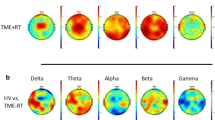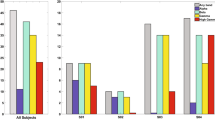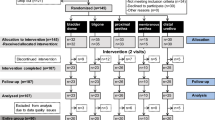Abstract
This study was designed to assess the excitability of the motor cortical representation of the external anal sphincter by using transcranial magnetic stimulation (TMS). In six healthy volunteers, the rest motor threshold and the duration of the cortical silent period were determined with single TMS pulses, and the intracortical inhibition and facilitation were measured with paired TMS pulses. Values obtained from the anal sphincter were compared with those obtained from a muscle in the right hand. All subjects completed the study. Rest motor threshold and intracortical facilitation were similar in both muscles. In contrast, cortical silent period duration and intra-cortical inhibition were less for the anal sphincter than for hand muscle. This study has opened new perspectives for the investigation of anal sphincter cortical control in humans.

Similar content being viewed by others
References
Abbruzzese G, Trompetto C (2002) Clinical and research methods for evaluating cortical excitability. J Clin Neurophysiol 19:307–321
Brittain KR, Peet SM, Castleden CM (1998) Stroke and incontinence. Stroke 29:524–528
Boroojerdi B, Kopylev L, Battaglia F, Facchini S, Ziemann U, Muellbacher W, Cohen LG (2000) Reproducibility of intracortical inhibition and facilitation using the paired-pulse paradigm. Muscle Nerve 23:1594–1597
Brouwer B, Ashby P (1990) Corticospinal projections to upper and lower limb spinal motoneurons in man. Electroencephalogr Clin Neurophysiol 76:509–519
Cantello R, Gianelli M, Civardi C, Mutani R (1992) Magnetic brain stimulation: the silent period after the motor evoked potential. Neurology 42:1951–1959
Chen R, Tam A, Bütefisch C, Corwell B, Ziemann U, Rothwell JC, Cohen LG (1998) Intracortical inhibition and facilitation in different representations of the human motor cortex. J Neurophysiol 80:2870–2881
Cruccu G, Inghilleri M, Berardelli A, Romaniello A, Manfredi M (1997) Cortical mechanisms mediating the inhibitory period after magnetic stimulation of the facial motor area. Muscle Nerve 20:418–424
Demoule A, Verin E, Ross E, Moxham J, Derenne JP, Polkey MI, Similowski T (2003) Intracortical inhibition and facilitation of the response of the diaphragm to transcranial magnetic stimulation. J Clin Neurophysiol 20:59–64
Desiato MT, Bernardi G, Hagi AH, Boffa L, Caramia MD (2002) Transcranial magnetic stimulation of motor pathways directed to muscles supplied by cranial nerves in amyotrophic lateral sclerosis. Clin Neurophysiol 113:132–140
Fritz C, Braune HJ, Pylatiuk C, Pohl M (1997) Silent period following transcranial magnetic stimulation: a study of intra- and inter-examiner reliability. Electroencephalogr Clin Neurophysiol 105:235–240
Ghezzi A, Callea L, Zaffaroni M, Zibetti A, Montanini R (1992) Perineal motor potentials to magnetic stimulation, pudendal evoked potentials and perineal reflex in women. Neurophysiol Clin 22:321–326
Herdmann J, Bielefeldt K, Enck P (1991) Quantification of motor pathways to the pelvic floor in humans. Am J Physiol 260:G720–G723
Herdmann J, Enck P, Zacchi-Deutschbein P, Ostermann U (1995) Speed and pressure characteristics of external anal sphincter contractions. Am J Physiol 269:G225–G231
Hinds JP, Wald A (1989) Colonic and anorectal dysfunction associated with multiple sclerosis. Am J Gastroenterol 84:587–595
Hopkinson NS, Sharshar T, Ross ET, Nickol AH, Dayer MJ, Porcher R, Jonville S, Moxham J, Polkey MI (2004) Corticospinal control of respiratory muscles in chronic obstructive pulmonary disease. Respir Physiol Neurobiol 141:1–12
Ilic TV, Meintzschel F, Cleff U, Ruge D, Kessler KR, Ziemann U (2002) Short-interval paired-pulse inhibition and facilitation of human motor cortex: the dimension of stimulus intensity. J Physiol (London) 545:153–167
Inghilleri M, Berardelli A, Cruccu G, Manfredi M (1993) Silent period evoked by transcranial stimulation of the human cortex and cervicomedullary junction. J Physiol (London) 466:521–534
Jost WH, Schimrigk K (1994) A new method to determine pudendal nerve motor latency and central motor conduction time to the external anal sphincter. Electroencephalogr Clin Neurophysiol 93:237–239
Kern MK, Arndorfer RC, Hyde JS, Shaker R (2004) Cerebral cortical representation of external anal sphincter contraction: effect of effort. Am J Physiol 286:G304–G311
Kujirai T, Caramia MD, Rothwell JC, Day BL, Thompson PD, Ferbert A, Wroe S, Asselman P, Marsden CD (1993) Corticocortical inhibition in human motor cortex. J Physiol (London) 471:501–519
Lefaucheur JP, Yiou R, Thomas C (2001) Pudendal nerve terminal motor latency: age effects and technical considerations. Clin Neurophysiol 112:472–476
Lefaucheur JP, Lofaso F (2002) Diaphragmatic silent period to transcranial magnetic cortical stimulation for assessing cortical motor control of the diaphragm. Exp Brain Res 146:404–409
Lefaucheur JP (2004) Intra-rectal ground electrode improves the reliability of motor evoked potentials recorded in the anal sphincter. Muscle Nerve, in press
Leis AA, Kofler M, Stokic DS, Grubwieser GJ, Delapasse JS (1993) Effect of the inhibitory phenomenon following magnetic stimulation of cortex on brainstem motor neuron excitability on the cortical control of brainstem reflexes. Muscle Nerve 16:1351–1358
Liepert J, Classen J, Cohen LG, Hallett M (1998) Task-dependent changes of intracortical inhibition. Exp Brain Res 118:421–426
Mertz HR (2003) Overview of functional gastrointestinal disorders: dysfunction of the brain-gut axis. Gastroenterol Clin North Am 32:463–476
Mulak A, Bonaz B (2004) Irritable bowel syndrome: a model of the brain-gut interactions. Med Sci Monit 10:RA55–RA62
Opsomer RJ, Caramia MD, Zarola F, Pesce F, Rossini PM (1989) Neurophysiological evaluation of central-peripheral sensory and motor pudendal fibers. Electroencephalogr Clin Neurophysiol 74:260–270
Orth M, Snijders AH, Rothwell JC (2003) The variability of intracortical inhibition and facilitation. Clin Neurophysiol 114:2362–2369
Orth M, Rothwell JC (2004) The cortical silent period: intrinsic variability and relation to the waveform of the transcranial magnetic stimulation pulse. Clin Neurophysiol 115:1076–1082
Pelliccioni G, Scarpino O, Piloni V (1997) Motor evoked potentials recorded from external anal sphincter by cortical and lumbo-sacral magnetic stimulation: normative data. J Neurol Sci 149:69–72
Podnar S (2003) Electrodiagnosis of the anorectum: a review of techniques and clinical applications. Tech Coloproctol 7:71–76
Ridding MC, Taylor JL, Rothwell JC (1995) The effect of voluntary contraction on cortico-cortical inhibition in human motor cortex. J Physiol (London) 487:541–548
Robain G, Chennevelle JM, Petit F, Piera JB (2002) Incidence de la constipation dans une population de patients atteints d’hémiplégie vasculaire récente : étude prospective de 152 cas. Rev Neurol (Paris) 158:589–592
Robinson LR, Goldstein BS, Little JW (1993) Silent period after electromagnetic stimulation of the motor cortex. Am J Phys Med Rehabil 72:23–28
Rossini PM, Barker AT, Berardelli A, Caramia MD, Caruso G, Cracco RQ, Dimitrijevic MR, Hallett M, Katayama Y, Lücking CH, Maertens de Noordhout AL, Marsden CD, Murray NMF, Rothwell JC, Swash M, Tomberg C (1994) Non-invasive electrical and magnetic stimulation of the brain, spinal cord and roots: basic principles and procedures for routine clinical application. Report of an IFCN committee. Electroencephalogr Clin Neurophysiol 91:79–92
Salerno A, Thomas E, Olive P, Blotman F, Picot MC, Georgesco M (2000) Motor cortical dysfunction disclosed by single and double magnetic stimulation in patients with fibromyalgia. Clin Neurophysiol 111:994–1001
Tergau F, Wanschura V, Canelo M, Wischer S, Wassermann EM, Ziemann U, Paulus W (1999) Complete suppression of voluntary motor drive during the silent period after transcranial magnetic stimulation. Exp Brain Res 124:447–454
Tremblay F, Tremblay LE (2002) Cortico-motor excitability of the lower limb motor representation: a comparative study in Parkinson’s disease and healthy controls. Clin Neurophysiol 113:2006–2012
Turnbull GK, Hamdy S, Aziz Q, Singh KD, Thompson DG (1999) The cortical topography of human anorectal musculature. Gastroenterology 117:32–39
Vodusek DB (2004) Anatomy and neurocontrol of the pelvic floor. Digestion 69:87–92
Welter ML, Dechoz S, Leroi AM, Weber J (2000) Réponses évoquées électriques et mécaniques du sphincter anal externe après stimulations magnétiques corticales et lombaires. Neurophysiol Clin 30:246–253
Werhahn KJ, Classen J, Benecke R (1995) The silent period induced by transcranial magnetic stimulation in muscles supplied by cranial nerves: normal data and changes in patients. J Neurol Neurosurg Psychiatr 59:586–596
Ziemann U, Netz J, Szelenyi A, Homberg V (1993) Spinal and supraspinal mechanisms contribute to the silent period in the contracting soleus muscle after transcranial magnetic stimulation of human motor cortex. Neurosci Lett 156:167–171
Ziemann U, Rothwell JC, Ridding MC (1996) Interaction between intracortical inhibition and facilitation in human motor cortex. J Physiol (London) 496:873–881
Author information
Authors and Affiliations
Corresponding author
Rights and permissions
About this article
Cite this article
Lefaucheur, JP. Excitability of the motor cortical representation of the external anal sphincter. Exp Brain Res 160, 268–272 (2005). https://doi.org/10.1007/s00221-004-2170-0
Received:
Accepted:
Published:
Issue Date:
DOI: https://doi.org/10.1007/s00221-004-2170-0




